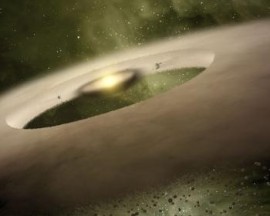Just before the planets form … – Protoplanetary Discs

DIANA is an European Framework Seven (FP7) project, SPACE-2011 collaboration, project no 284405, which conducts a systematic collection and coherent analysis of observational data from the birth-places of extrasolar planets, the so-called protoplanetary discs. DIANA stands for DIscANAlysis.
The project aims at concerted efforts to collect public and proprietary multi-wavelength data for protoplanetary discs (e.g. SPITZER, HERSCHEL, XMM, HST, VLT, JCMT, ALMA, eMERLIN). Large amounts of survey data exist, but are currently seriously underutilised. We will mainly use our FP7 resources for the manpower to collect, analyse and interpret these data by means of novel high-quality disc models. Besides archival data, our team has access to the latest results from ongoing observational key programmes (from X-ray to cm wavelength), and these data need to be folded in to probe the conditions for planet formation, such as density, temperature and chemical composition, over the discs’ full radial extent.
The following European institutions are involved
- School of Physics & Astronomy in the University of St Andrews (UK)
- Astronomical Institute Anton Pannekoek in Amsterdam (NL)
- Kapteyn Astronomical Institute in Groningen (NL)
- Institut de Planetologie et d’Astrophyique de Grenoble IPAG (F)
- Institut fuer Astronomie der Universitaet Wien (A).
Our team also covers the required modelling know-how to reach an unprecedented level of completeness concerning the inclusion of important physical processes (astrochemistry, gas heating & cooling, dust evolution, continuum & line radiative transfer, non-LTE modelling). We also aim for a breakthrough in wavelength-coverage and completeness as to how the models are compared to observations (photometry, interferometry, line fluxes, line profiles and images).
Based on these multi-wavelength data sets and our detailed modelling efforts, we will be able to determine the physical and chemical structure of the discs, and answer a number of fundamental questions related to planet formation, for example, how the gas and dust in discs evolve in time, how important the stellar UV and X-ray irradiation is, and how the presence of planets alters the disc structure. We will capitalise on our unique team expertise in observations & modelling to make the best use of existing European space-mission data to explore disc evolution and the initial conditions of planet formation.